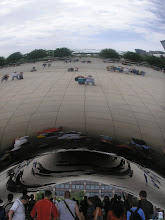In 1947, Corinne Chochem, a Russian dancer well-known for her promotion of Jewish music, dance, and art in New York, approached Arnold Schoenberg with her idea of a musical work to honor the Jewish victims of Nazi rule during WWII. Schoenberg, born a Jew, had converted to Protestantism in 1898, but returned to his Jewish faith in 1933, moved by “the hideous persecution of Jews at the hands of the Nazis.” (Slonimsky and Kuhn 2001) Schoenberg proposed the piece be between 6 to 9 minutes, the subject would be how Jewish victims sang before they were killed, and the price would be $1,000. Unfortunately for Chochem, $1,000 was a lot of money in 1947, and so she was forced to abandon the project. Fortunately for the world of music, Schoenberg could not part with this picture of the singing Jews.
Soon after his correspondence with Chochem, Schoenberg received word from the Koussevitzky Foundation, informing him they were interested in commissioning an orchestral work. Schoenberg replied, saying he had just the piece, and that although he originally intended it for orchestra with narrator and men’s chorus, he now envisioned it as a symphonic poem. However, Serge Koussevitzky encouraged Schoenberg to use his original orchestration. When finally finished, A Survivor from Warsaw was premiered on November 4, 1948 by the Albuquerque Civic Orchestra, an orchestra of “lawyers, doctors, secretaries, high school and university students, railroad engineers, etc.” (Strasser 1995, 56) It was by no means a major American orchestra, but a work of this magnitude spoke for itself. Since its brilliant premiere, it has remained a musical monument. As historian Michael Strasser describes,
“The emotional impact that A Survivor from Warsaw had on the performers and audience at the Albuquerque premiere has not dimmed with time… for the event to which it bears witness… is a crime unparalleled in the annals of human history… Schoenberg’s composition continues to serve as an eloquent reminder of the enormity of the crime that took place half a century ago.” (Strasser 1995, 57)
The piece, which is divided into two sections, begins with a quirky trumpet reveille building to loud, dissonant chords in the strings and brass. After the introduction, the narrator enters and begins telling the speaker’s story. It is the story of a concentration camp prisoner awakening to the daily horrors of the camp. Nazi guards beat the prisoners after they have emerged from their cells, before the prisoners are sent to the gas chambers. The painfully detailed narration is accompanied by dissonant and mostly athematic elements in the orchestra. The only thematic material presented in this section is in a trumpet reveille and in a snare drum march beat. The athematic music seems almost deconstructed- unorganized musical fragments depict the Jewish prisoners, beaten down under the cruelty, oppression and regimentation of the prison guards.
The turning point in the piece comes, however, with the beginning of the second section. Although it lasts only 19 measures (compared to the 80 measures in the first section), the second section is even more emotionally stirring. The frenzied music and shouting of the narrator builds until the narrator cries “they began singing, ‘Shema Yisroel’!” At this point the men’s chorus begins singing “Shema Yisroel”, a Jewish prayer which, translated from Hebrew says
“Hear Israel: The Lord our God is one Lord, And you shall love the Lord, your God, With all your heart and with all your soul And with all your might. And these words, which I command you today, Shall be in all your heart; And you shall teach them diligently to your children and talk of them When you sit in your house And when you walk along your way, When you lie down and when you rise.” (Auner 2003, 319)
In this glorious section we finally hear thematic material, in the form of this Jewish hymn. The voices of the doomed Jews break free of and rise above the cacophonous violence of their oppressors, even as they are taken to their deaths. Schoenberg shows the spirit of the Jewish people triumphing over their hardships through the emergence of their song and its triumph over the fragmented style of the first section.
I have to wonder how effective this piece would have been as a symphonic poem. Certainly Schoenberg could have still employed the effect of the contrast between sections to show the oppression and ultimate triumph of the spirits of the Jewish people. However, I find the narration in the first section to be indispensable to depicting the horrors of the story and the sounds and words of the men’s voices to be an emotional climax that would otherwise be unattainable.
I do believe this piece should be included in the canon. It is very well orchestrated, has a stirring narration, and expertly makes use of a Jewish hymn using Schoenberg’s 12 tone system. For these reasons I believe this piece is not only a musical masterpiece, but also a fitting honor to those who perished in the genocide.
Subscribe to:
Post Comments (Atom)


No comments:
Post a Comment